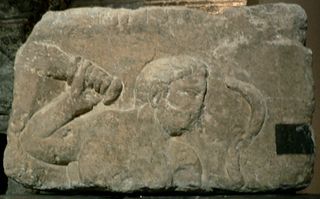「スメルトリオス」の版間の差分
| 1行目: | 1行目: | ||
[[Image:Le_Pilier_des_Nautes_06.jpeg|320px|thumb|right|「船乗りの柱」に描かれたスメルトリウスのレリーフ(パリ)。]] | [[Image:Le_Pilier_des_Nautes_06.jpeg|320px|thumb|right|「船乗りの柱」に描かれたスメルトリウスのレリーフ(パリ)。]] | ||
| − | ガロ・ローマ時代の宗教では、スメルトリオスまたはスメルトリウスはガリアとノリクム<ref>現代のオーストリアとスロベニアの領域に位置したケルト人の王国。</ref>で崇拝された軍神であった<ref>Nicole Jufer & Thierry Luginbühl. 2001. ''Les dieux gaulois : répertoire des noms de divinités celtiques connus par l'épigraphie, les textes antiques et la toponymie.'' Editions Errance, Paris.</ref> | + | ガロ・ローマ時代の宗教では、スメルトリオスまたはスメルトリウスはガリアとノリクム<ref>現代のオーストリアとスロベニアの領域に位置したケルト人の王国。</ref>で崇拝された軍神であった<ref>Nicole Jufer & Thierry Luginbühl. 2001. ''Les dieux gaulois : répertoire des noms de divinités celtiques connus par l'épigraphie, les textes antiques et la toponymie.'' Editions Errance, Paris.</ref>。ローマではマールスと同一視されていた。 |
2022年11月23日 (水) 20:58時点における版
ガロ・ローマ時代の宗教では、スメルトリオスまたはスメルトリウスはガリアとノリクム[1]で崇拝された軍神であった[2]。ローマではマールスと同一視されていた。
In Gallo-Roman religion, Smertrios or Smertrius was a god of war worshipped in Gaul and Noricum. In Roman times he was equated with Mars. His name contains the same root as that of the goddess Rosmerta and may mean "The Purveyor" or "The Provider", a title rather than a true name. Smertulitanus may be a variant name for the same god.
Smertrius is one of the Gaulish gods depicted on the Pillar of the Boatmen, discovered in Paris. Here is depicted as a well-muscled bearded man confronting a snake which rears up in front of him. The god brandishes an object which has usually been interpreted as a club but which rather resembles a torch or firebrand.
The normal interpretation of the god's attribute as a club has led to the identification, by modern scholars, of Smertrius and Hercules. Other evidence links Smertrius with the Celtic version of Mars: at Möhn near Trier, a spring sanctuary was dedicated to Mars Smertrius and his consort Ancamna. Coins found here indicate that there was a shrine here before the Roman period. Another Treveran inscription links Mars and Smertrius. Smertrius himself is known outside Gaul, for example on a fragmentary inscription at Grossbach in Austria.
References
- Dictionary of Celtic Myth and Legend. Miranda Green. Thames and Hudson Ltd. London. 1997
